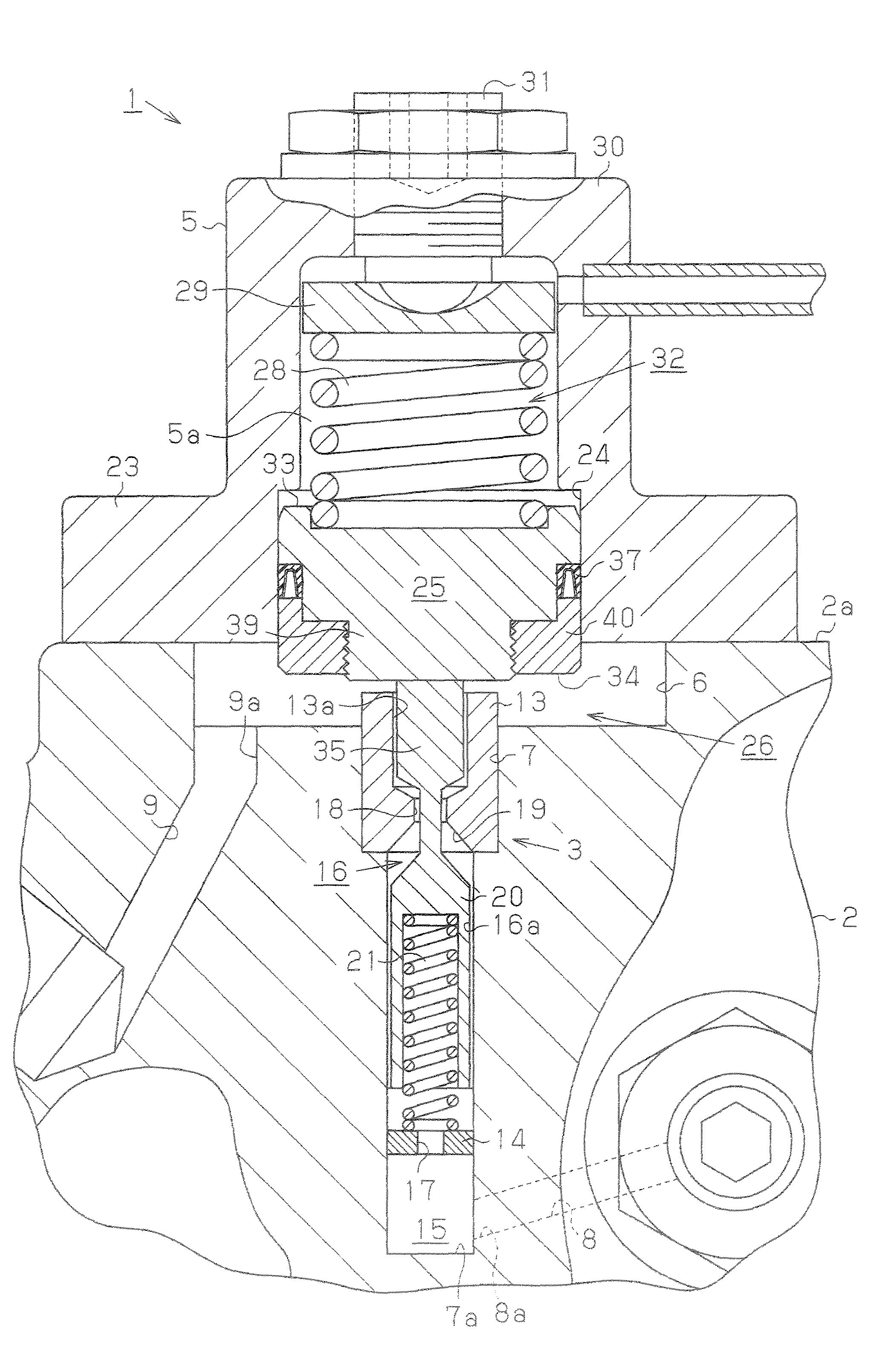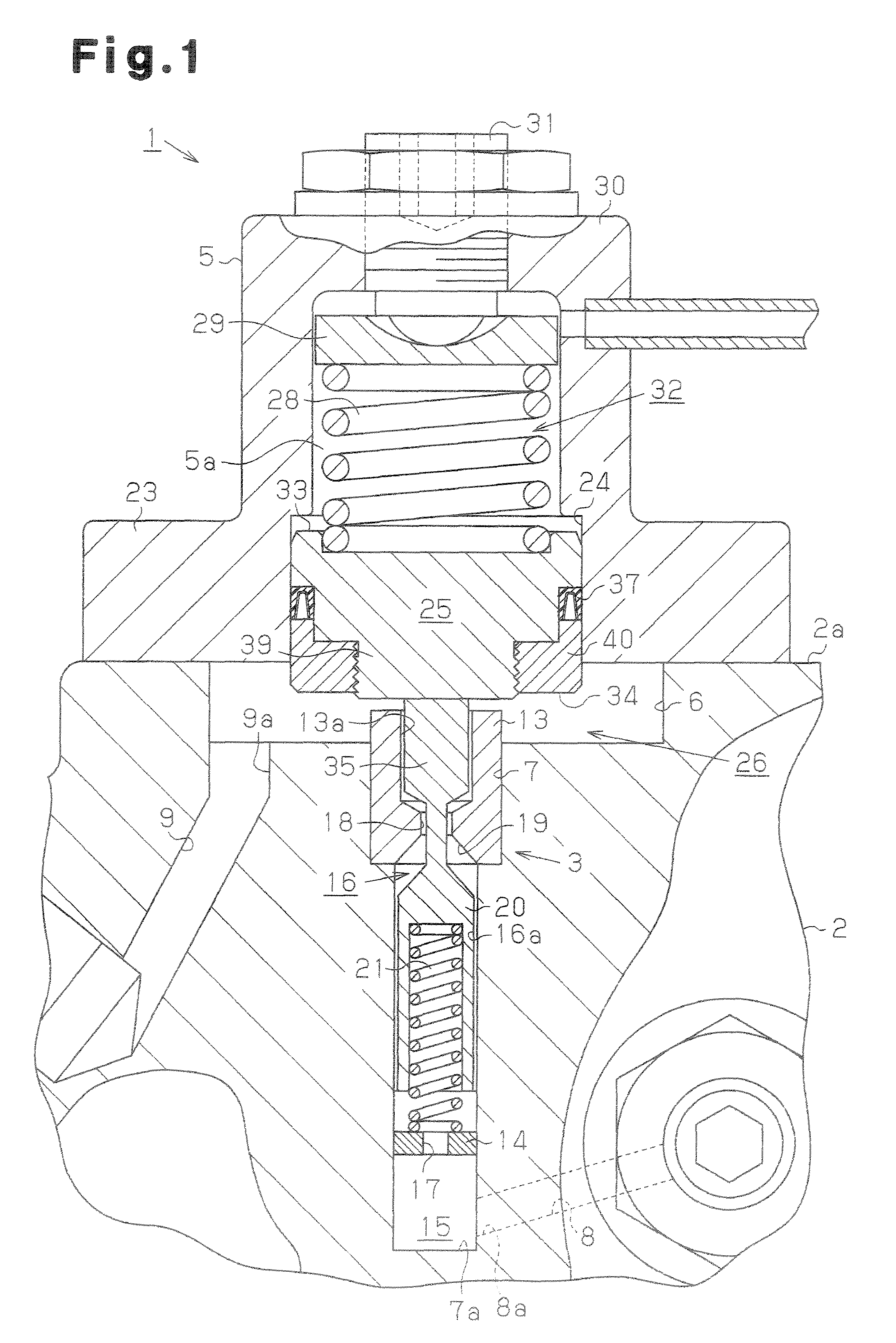Pressure-reducing valve
a technology of pressure reducing valve and piston, which is applied in the direction of fluid pressure control, container discharge methods, instruments, etc., can solve the problems of lowering the regulation accuracy of gas pressure and interfering with the movement of the piston, and achieves high-precision pressure regulation and prevents the axial displacement of the piston
- Summary
- Abstract
- Description
- Claims
- Application Information
AI Technical Summary
Benefits of technology
Problems solved by technology
Method used
Image
Examples
first embodiment
[0023]A first embodiment of the present invention will now be described with reference to the drawings.
[0024]As shown in FIG. 1, a pressure reducing valve 1 (regulator) of the present embodiment is mounted on a plug housing 2 for closing an opening of a high-pressure hydrogen tank. The pressure reducing valve 1 includes a valve mechanism 3 formed in the plug housing 2 and an outer housing 5 or closing an opening of the plug housing 2.
[0025]The plug housing 2 includes a first recess 6 and a second recess 7, which is arranged in the center of the first recess 6 and is deeper than the first recess 6. An inlet passage 8, which is in communication with the interior of the hydrogen tank, is formed in a side wall in the vicinity of a bottom surface 7a of the second recess 7. An outlet passage 9, which is in communication with an external supply port, is formed in a bottom surface of the first recess 6. In the present embodiment, an inner end of the inlet passage 8 forms a primary port 8a, ...
second embodiment
[0043]A second embodiment of the present invention will now be described with reference to the drawings. A pressure reducing valve of the present embodiment differs from the pressure reducing valve 1 of the first embodiment described above only in the structure for fixing the seal of the piston. To facilitate description, the components of the present embodiment that are the same as the components in the first embodiment are given the same reference numerals and will not be described.
[0044]As shown in FIG. 3, a pressure reducing valve 51 of the present embodiment includes a fixing ring 55, which serves as an annular fixing member, fitted in an accommodating groove 53 of a piston 52 together with a lip seal 54. The lip seal 54 is held between the fixing ring 55 and the accommodating groove 53, more specifically, between a contact surface 55b of the fixing ring 55 and a bottom surface 53b of the accommodating groove 53. The inner diameter of the fixing ring 55 is set to be substantial...
third embodiment
[0046]A third embodiment of the present invention will now be described with reference to the drawings. A pressure reducing valve of the present embodiment differs from the pressure reducing valve 1 of the first embodiment described above only in the structure for fixing the seal of the piston. To facilitate description, the components of the present embodiment that are the same as the components in the first embodiment are given the same reference numerals and will not be described.
[0047]As shown in FIG. 4 a pressure reducing valve 61 of the present embodiment includes a press-fitting groove 66, which is in communication with an accommodating groove 65 for accommodating a lip seal 64. The press-fitting groove 66 is formed around a head portion 63 of a piston 62 in the vicinity of a pressure receiving surface 34 of the piston 62. A fixing ring 67, which serves as an annular fixing member, is press-fitted in the press-fitting groove 66. The outer diameter of the fixing ring 67 is sub...
PUM
 Login to View More
Login to View More Abstract
Description
Claims
Application Information
 Login to View More
Login to View More - R&D
- Intellectual Property
- Life Sciences
- Materials
- Tech Scout
- Unparalleled Data Quality
- Higher Quality Content
- 60% Fewer Hallucinations
Browse by: Latest US Patents, China's latest patents, Technical Efficacy Thesaurus, Application Domain, Technology Topic, Popular Technical Reports.
© 2025 PatSnap. All rights reserved.Legal|Privacy policy|Modern Slavery Act Transparency Statement|Sitemap|About US| Contact US: help@patsnap.com



